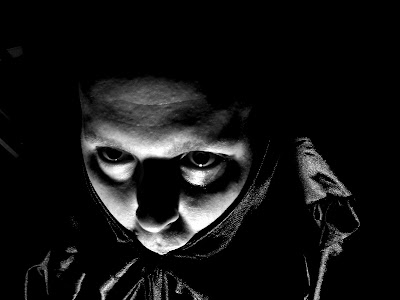From Bujinkan Santa Monica by Michael
 |
| Monomania-Light and Its Grand Narrator, photo by DerrickT |
How do you train to be a ninja nightmare? I was attending a class with Hatsumi Sensei when he did something terrible to his uke. I mean it was so hideous and gross I don't want to repeat it here. Maybe later in this article I'll work up the nerve.
Then he looked at the expressions of everyone watching and told us, as if we just didn't get it... When you are dealing with bad people, you have to do worse than they'd expect.
This idea gets to the heart of a big problem with training. We get too comfortable in our dojos and our knowledge. Training becomes habit. We lean on technique. We become reliable and complacent in our ability.
Bad people, or desperate and crazy people willing to do bad things, are the opposite. They will go to any lengths. They will have no technique. They will do things that just don't make sense. That is hard to defend against.
So we can take a lesson from them and drop the "common sense" or the group think or dojo inbreeding that gets everyone training sensibly. Anytime anyone says that "this" or "that" is the way something should be done, I try recognize that for what it is… a trap. I think, "Maybe that's the way YOU do it!" Memorized kata or techniques are a disease.
Sensei urges us to separate ourselves from the waza so that we see the whole picture. If you think in your own mind, "this is the common sense way to do the technique," that is very dangerous. He has told us to use 非常識 hijoushiki which is a lack of common sense.
I'm definitely not using common sense in giving away my current training notes. I explain why I'm doing this here:
稽古記録 Keiko Kiroku
Hijoushiki. This idea is not new to Budo. It goes back to some of the earliest documents in Japan. An example is the Shinden Kohyō no Hikan where the "Starving tiger" or even "Nursing tiger" kamae might reflect this spirit.
But beyond this is a secret or hidden sense. Another kanji for hijoushiki is 秘常識. This feeling is described in the Koteki Ryoda scrolls. Here you develop the uncommon sense or the secret sense yet still very natural ability to predict, sense, and see through things.
Sensei tells us that if you try to memorize these forms you will end up trapped. He says that any conventional "common sense" about the martial arts prevents you from adapting or changing. He writes,
"In real life, people who live beyond the bounds of common sense attack you suddenly, with scant regard for rules of combat."
Soke punched the guy in the throat. Not from the outside like common sense would lead you to believe. His fist was in his uke's mouth and he said to punch it down the esophagus and then maybe rip the tongue out as you withdraw. It was shocking to witness. His poor uke definitely had to learn some sutemi that night.
So when dealing with bad or crazy people, this might be the only way to communicate some sense in a language they can relate to. Do worse than they'd expect. Be worse than their nightmares. They can't prepare or defend against that.



…









